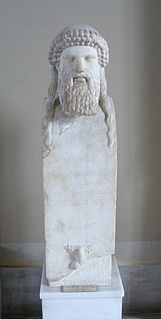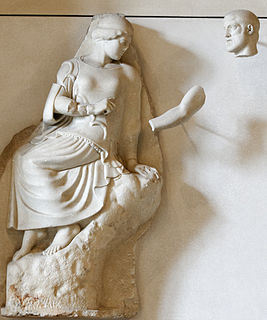
Alcamenes was an ancient Greek sculptor of Lemnos and Athens, who flourished in the 2nd half of the 5th century BC. He was a younger contemporary of Phidias and noted for the delicacy and finish of his works, among which a Hephaestus and an Aphrodite "of the Gardens" were conspicuous.

Aeacus was a mythological king of the island of Aegina in the Saronic Gulf.

Phidias or Pheidias was a Greek sculptor, painter, and architect. His statue of Zeus at Olympia was one of the Seven Wonders of the Ancient World. Phidias also designed the statues of the goddess Athena on the Athenian Acropolis, namely the Athena Parthenos inside the Parthenon, and the Athena Promachos, a colossal bronze which stood between it and the Propylaea, a monumental gateway that served as the entrance to the Acropolis in Athens. Phidias was the son of Charmides of Athens. The ancients believed that his masters were Hegias and Ageladas.

Aphaea was a Greek goddess who was worshipped almost exclusively at a single sanctuary on the island of Aegina in the Saronic Gulf. She originated as early as the 14th century BCE as a local deity associated with fertility and the agricultural cycle. Under Athenian hegemony, however, she came to be identified with the goddesses Athena and Artemis and with the nymph Britomartis as well, by the 2nd century CE, the time of Pausanias:
On Aigina as one goes toward the mountain of Zeus, god of all the Hellenes, the sanctuary of Aphaia comes up, for whom Pindar composed an ode at the behest of the Aeginetans. The Cretans say that Euboulos was the son of Kharmanor, who purified Apollo of the killing of the Python, and they say that Britomartis was the daughter of Zeus and Kharme. She enjoyed races and hunts and was particularly dear to Artemis. While fleeing from Minos, who lusted after her, she cast herself into nets cast for a catch of fish. Artemis made her a goddess, and not only the Cretans but also the Aeginetans revere her. The Aeginetans say that Britomartis showed herself to them on their island. Her epithet among the Aeginetans is Aphaia, and it is Diktynna of the Nets on Crete. Description of Greece 2.30.3

Praxiteles of Athens, the son of Cephisodotus the Elder, was the most renowned of the Attic sculptors of the 4th century BC. He was the first to sculpt the nude female form in a life-size statue. While no indubitably attributable sculpture by Praxiteles is extant, numerous copies of his works have survived; several authors, including Pliny the Elder, wrote of his works; and coins engraved with silhouettes of his various famous statuary types from the period still exist.
Ageladas or Hagelaedas was a celebrated Greek (Argive) sculptor, who flourished in the latter part of the 6th and the early part of the 5th century BC.

Pausanias was a Greek traveler and geographer of the second-century AD, who lived in the time of Roman emperors Hadrian, Antoninus Pius, and Marcus Aurelius. He is famous for his Description of Greece, a lengthy work that describes ancient Greece from his first-hand observations. This work provides crucial information for making links between classical literature and modern archaeology. Andrew Stewart assesses him as:
A careful, pedestrian writer ... interested not only in the grandiose or the exquisite but in unusual sights and obscure ritual. He is occasionally careless or makes unwarranted inferences, and his guides or even his own notes sometimes mislead him, yet his honesty is unquestionable, and his value without par.

Chryselephantine sculpture is sculpture made with gold and ivory. Chryselephantine cult statues enjoyed high status in Ancient Greece.
Praxias and Androsthenes, Greek sculptors, who are said by Pausanias to have executed the pediments of the temple of Apollo at Delphi. Both were Athenians, Praxias a pupil of Calamis. The statement raises historic difficulties, as, according to the leaders of the recent French excavations at Delphi, the temple of Apollo was destroyed about 373 BC and rebuilt by 339 BC, a date which seems too late for the lifetime of a pupil of Calamis. In any case no fragments of the pediments of this later temple have been found, and it has been suggested that they were removed bodily to Rome.

The Temple of Zeus at Olympia was an ancient Greek temple in Olympia, Greece, dedicated to the god Zeus. The temple, built in the second quarter of the fifth century BC, was the very model of the fully developed classical Greek temple of the Doric order.
In Greek mythology, Harpina was a Naiad nymph and daughter of Phliasian Asopus and of Metope. Pausanias (5.22.6) and Diodorus Siculus (4.73.1) mention Harpina and state that, according to the tradition of the Eleans and Phliasians, Ares mated with her in the city of Pisa and she bore him Oenomaus, the king of Pisa. Oenomaus (6.21.8) founded and named after his mother the city of Harpina, not far from the river Harpinates, near Olympia. Pausanias (5.22.6) mentions Harpina in his description of a group sculpture, donated by the Phliasians, of the daughters of Asopus, which included Nemea, Zeus seizing Aegina, Harpina, Corcyra, Thebe and Asopus. The sculpture was located in the sanctuary of Hippodamia at Olympia.

The Temple of Aphaia or Afea is located within a sanctuary complex dedicated to the goddess Aphaia on the Greek island of Aigina, which lies in the Saronic Gulf. Formerly known as the Temple of Jupiter Panhellenius, the great Doric temple is now recognized as dedicated to the mother-goddess Aphaia. It was a favorite of the neoclassical and romantic artists such as J. M. W. Turner. It stands on a c. 160 m peak on the eastern side of the island approximately 13 km east by road from the main port.

In ancient Greek cult, kriophoros or criophorus, the "ram-bearer," is a figure that commemorates the solemn sacrifice of a ram. It becomes an epithet of Hermes: Hermes Kriophoros.

The Olympia Master is the name given to the anonymous sculptor responsible for the external sculpture of the Temple of Zeus, Olympia. From what Pausanias tells us of the dates of the Temple, the Master and his workshop were active between 470 and 457 BCE The two pediments and the series of metopes ascribed to him are the paradigmatic expression of the Early Classical or Severe style of 5th century Greek sculpture.
Ptolichus is a name attributed to two individuals from Classical antiquity:
Aristocles is a name attributed to two sculptors in Ancient Greece, as well as a nominal hereditary school of sculpture, started by the elder Aristocles, known to us primarily through different passages in Pausanias.
Anaxagoras of Aegina was a sculptor who lived around 480 BCE, and created the statue of Zeus in bronze set up at Olympia by the states which had united in repelling the invasion of Xerxes I of Persia. He is supposed to be the same person as the sculptor mentioned in an epigram by Anacreon, but not the same as the writer on scene-painting mentioned by Vitruvius.
One of the most famous ex votos in the sanctuary of Apollo in Delphi was the bronze bull dedicated by the citizens of Corfu in remembrance of a remarkable tuna fish catch.
One of the important ex votos of the Greek cities in the sanctuary of Delphi was the bronze sculpted ex voto of the Italian city of Tarentum in commemoration of their victory against the Messapians.

The pediments of the Parthenon are the two sets of statues in Pentelic marble originally located on the east and west facades of the Parthenon on the Acropolis of Athens. They were likely made by several artists, including Agoracritos. The master builder was likely Phidias.












